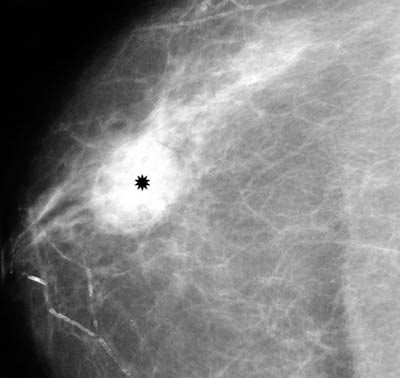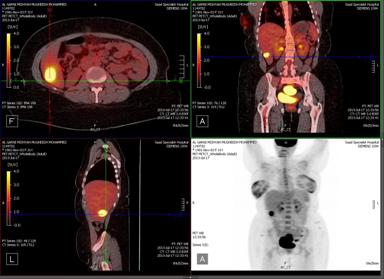Radiology
What is radiation therapy?
About 60 % of cancer patients are treated with radiation at some time during their course of treatment.
Radiation therapy is the use of high-energy radiation to treat cancer. A radiation oncologist may use radiation to cure cancer or to relieve a cancer patient's pain or alleviate other symptoms due to the cancer.
Radiation therapy works because the radiation destroys the cancer cells' ability to reproduce, and the body naturally gets rid of these cells. Radiation affects cancer cells by damaging their DNA, so that the cancer cells can no longer divide and grow. Radiation is most effective at killing cells that are actively dividing. Cancer cells are more vulnerable to radiation for two key reasons: they divide more rapidly than normal cells, and they do not repair this damage as effectively as normal cells.
A radiation oncologist may use external beam radiation therapy generated by a linear accelerator (a machine that accelerates electrons to produce x-rays or gamma rays). Proton therapy is another form of external beam radiation therapy that uses cyclotrons or synchrotrons to produce charged atoms that destroy tumors.
 Radiation may also be given with radioactive sources that are put inside the patient brachytherapy. The radioactive sources are sealed in needles, seeds, wires, or catheters, and implanted directly into or near a tumor on a temporary or permanent basis. Brachytherapy is a common treatment for cancers of the prostate, uterus, cervix or breast.
Radiation may also be given with radioactive sources that are put inside the patient brachytherapy. The radioactive sources are sealed in needles, seeds, wires, or catheters, and implanted directly into or near a tumor on a temporary or permanent basis. Brachytherapy is a common treatment for cancers of the prostate, uterus, cervix or breast.
Some cancer patients may be treated with radiation alone instead of surgery. Prostate cancer and larynx cancer are often treated in this manner.
Sometimes radiation therapy is part of a patient's treatment. When radiation therapy is used after surgery, it is called adjuvant treatment. For example, a woman may have radiation therapy after breast conserving surgery. She can be cured of her cancer and still keep her breast.
In some cases, such as lung, head and neck or cervix cancers, combined modality therapy may be the only treatment needed without surgery.
Since radiation can damage normal cells, it is important that the radiation dose be targeted precisely to the cancer. Imaging also helps with treatment planning, allowing precise radiation delivery that spares surrounding, healthy tissue and minimizes side effects and complications.
An advanced form of three-dimensional (3-D) conformal radiation, called intensity modulated radiation therapy or IMRT, more precisely conforms the dose to the tumors, allowing safer delivery of higher than conventional doses of radiation. Image-guided radiation therapy or IGRT is often used in conjunction with intensity-modulated radiation therapy (IMRT) to deliver precise radiation doses to a malignant tumor or even specific areas within the tumor. Recent developments like IGRT even allow for adjustments during treatment in areas of the body that are prone to movement, such as the lungs, and tumors located close to critical organs and tissues.
 Other techniques that enable ultra-precise doses of radiation to tumors include stereotactic radiosurgery, which uses 3-D imaging to determine the exact coordinates of a tumor. The highly focused gamma rays or x-rays then converge on the tumor to treat it. The Gamma Knife® is a treatment option that uses radioactive cobalt sources to focus multiple beams of radiation on a small area. Linear accelerators can also be used to deliver stereotactic radiation therapy to the brain. Other parts of the body can be treated as well, and are considered stereotactic body radiation therapy (SBRT). Emerging areas for using SBRT include lung, liver and bone.
Other techniques that enable ultra-precise doses of radiation to tumors include stereotactic radiosurgery, which uses 3-D imaging to determine the exact coordinates of a tumor. The highly focused gamma rays or x-rays then converge on the tumor to treat it. The Gamma Knife® is a treatment option that uses radioactive cobalt sources to focus multiple beams of radiation on a small area. Linear accelerators can also be used to deliver stereotactic radiation therapy to the brain. Other parts of the body can be treated as well, and are considered stereotactic body radiation therapy (SBRT). Emerging areas for using SBRT include lung, liver and bone.
Radiation can also be used to cut off blood flow to a tumor in vascular organs like the liver. For instance, radioembolization uses microspheres filled with radioactive isotopes to block a tumor's blood supply and starve it.
In addition to being a treatment option for cancer, radiation therapy also is palliative; that is, it can help reduce pain and suffering in patients with advanced cancer. Patients with significant pain, trouble walking or difficulty eating because of a tumor can see an improved quality of life through palliative radiation.




